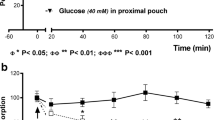Abstract
The effect of capsaicin-sensitive afferent nerves on the alkaline secretory response induced by mucosal acidification was investigated in theex vivo stomachs of anesthetized rats. The stomach was mounted on a Lucite chamber and perfused with saline (pH 4.5) in the absence of acid secretion (omeprazole pretreatment: 60 mg/kg, intraperitoneal), and luminal pH and transmucosal potential difference (PD) were monitored simultaneously. Under these conditions the gastric mucosa responded to intravenous infection of prostaglandin E2 (PGE2: 300 μg/kg) and mucosal acidification (0.2 N HCl for 10 min) by a significant increase of pH with a slight decrease of PD; the HCO3 − output was 9.2±0.7 μmol and 8.4±0.8 μmol, respectively. The increased pH and HCO3 − responses were significantly inhibited by prior administration of indomethacin (5 mg/kg, subcutaneously) or chemical deafferentation following capsaicin injections (total dose: 100 mg/kg, subcutaneously), whereas those induced by PGE2 remained unchanged after either treatment. On the other hand, the mucosal application of capsaicin (0.3–6 mg/ml) increased the luminal pH and HCO3 − output in a concentration-related manner, and this action was also significantly attenuated by either indomethacin or chemical deafferentation of capsaicin-sensitive sensory neurons. These results suggest that capsaicin-sensitive sensory nerves may be involved in the mechanism of acid-induced HCO3 − secretion in the stomach, in addition to endogenous PGs, and these two pathways may interact somewhere in the stimulatory process.
Similar content being viewed by others
References
Flemstrom G, Turnberg LA: Gastroduodenal defense mechanisms. Clin Gastroenterol 13:327–354, 1984
Garner A, Flemstrom G, Allen A, Heylings JR, McQueen S: Gastric mucosal protective mechanism: Roles of epithelial bicarbonate and mucus secretions. Scand J Gastroenterol 19:79–86, 1984
Takeuchi K, Nishiwaki H, Tanaka H, Niida H, Okabe S: Effect of pirenzepine on gastroduodenal alkaline secretion in anesthetized rats. Ther Res 10:467–476, 1989
Feitelberg SP, Hogan DL, Koss MA, Isenberg JI: pH threshold of human proximal duodenal mucosal bicarbonate secretion is 3. Gastroenterology 99:A-821, 1990 (abstract)
Heylings JR, Garner A, Flemstrom G: Regulation of gastroduodenal HCO3 − transport by luminal acid in the frogin vitro. Am J Physiol 246:G235-G246, 1984
Takeuchi K, Tanaka H, Furukawa O, Okabe S: Gastroduodenal HCO3 − secretion in anesthetized rats: Effect of 16,16-dimethyl PGE2, topical acid, and acetazolamide. Jpn J Pharmacol 41:91–100, 1986
Esplugues JV, Ramos EG, Gil L, Esplugues J: Influence of capsaicin-sensitive afferent neurons on the acid secretory responses of the rat stomachin vivo. Br J Pharmacol 100:491–496, 1990
Holzer P, Lippe IT, Holzer-Petsche U: Inhibition of gastrointestinal transit due to surgical trauma or peritoneal irritation is reduced in capsaicin-treated rats. Gastroenterology 91:360–363, 1986
Takeuchi K, Niida H, Matsumoto J, Ueshima K, Okabe S: Gastric motility changes in capsaicin-induced cytoprotection in the rat stomach. Jpn J Pharmacol 55:147–156, 1991
Matsumoto J, Ueshima K, Takeuchi K, Okabe S: Capsaicin-sensitive afferent neurons in adaptive responses of the rat stomach induced by a mild irritant. Jpn J Pharmacol 55:191–195, 1991
Takeuchi K, Ueshima K, Okabe S: Determination of gastroduodenal alkaline response in the rat. J Pharmacol Methods 24:189–202, 1990
Takeuchi K, Niida H, Ueshima K, Okabe S: Stimulation of gastric alkaline secretion by YM-14673, a TRH analog, in rats. J Pharmacol Exp Ther 256:1057–1062, 1991
Esplugues JV, Whittle BJR: Morphine potentiation of ethanol-induced gastric mucosal damage in the rat. Gastroenterology 98:82–89, 1990
Yonei Y, Holzer P, Guth PH: Laparotomy-induced gastric protection against ethanol injury is mediated by capsaicin-sensitive sensory neurons. Gastroenterology 99:3–9, 1990
Dunnett CW: A multiple comparison procedure for comparing several treatments with a control. Am J Stat Assoc 50:1096–1121, 1955
Whittle BJR, Higgs GA, Eakins KE, Moncada S, Vane JR: Selective inhibition of prostaglandin production in inflammatory exudates and gastric mucosa. Nature 284:272–273, 1980
Buck SH, Burks TF: The neuropharmacology of capsaicin: Review of some recent observations. Pharmacol Rev 38:179–226, 1986
Green TM, Dockray GJ: Characterization of the peptidergic afferent innervation of the stomach in the rat, mouse and guinea pigs. Neuroscience 25:181–193, 1988
Takeuchi K, Niida H, Okabe S: Characterization of alkaline secretion induced by cholinergic agents in the rat duodenum: Involvement of muscarinic M2 receptors and Ca-dependent process. J Pharmacol Exp Ther 254:465–470, 1990
Takeuchi K, Matsumoto J, Ueshima K, Okabe S: Role of capsaicin-sensitive afferent neurons in alkaline secretory responses to luminal acid in the rat duodenum. Gastroenterology 101:954–961, 1991
Holzer P, Sametz W: Gastric mucosal protection against ulcerogenic factors in the rat mediated by capsaicin-sensitive neurons. Gastroenterology 91:975–981, 1986
Holzer P, Lippe IT: Stimulation of afferent nerve endings by intragastric capsaicin protects against ethanol-induced damage of gastric mucosa. Neuroscience 27:981–987, 1988
Holzer P, Pabst MA, Lippe IT, Peskar BM, Peskar BA, Livingston EH, Guth PH: Afferent nerve-mediated protection against deep mucosal damage in the rat stomach. Gastroenterology 98:838–848, 1990
Holzer P, Livingston EH, Guth PH: Sensory neurons signal for an increase in rat gastric mucosal blood flow in response to acid back-diffusion. Gastroenterology 99:A-1845, 1990 (abstract)
Uchida M, Yano S, Watanabe K: The role of capsaicin-sensitive afferent nerves in protective effect of capsaicin against absolute ethanol-induced gastric lesions in rats. Jpn J Pharmacol 55:279–282, 1991
Lippe ITh, Pabst MA, Holzer P: Intragastric capsaicin enhances rat gastric acid elimination and mucosal blood flow by afferent nerve stimulation. Br J Pharmacol 96:91–100, 1989
Takeuchi K, Niida H, Okabe S: Gastric motility changes in the cytoprotective action of orally administeredN-ethylmaleimide and capsaicin in the rat stomach. Gastroenterology 98:A-134, 1990 (abstract)
Stern AI, Hogan DL, Isenberg JI: A new method for quantitation of ion fluxes acrossin vivo human gastric mucosa: Effect of aspirin, acetaminophen, ethanol, and hyperosmolar solutions. Gastroenterology 86:60–70, 1984
Author information
Authors and Affiliations
Rights and permissions
About this article
Cite this article
Takeuchi, K., Ueshima, K., Matsumoto, J. et al. Role of capsaicin-sensitive sensory nerves in acid-induced bicarbonate secretion in rat stomach. Digest Dis Sci 37, 737–743 (1992). https://doi.org/10.1007/BF01296432
Received:
Revised:
Accepted:
Issue Date:
DOI: https://doi.org/10.1007/BF01296432




